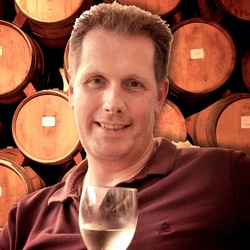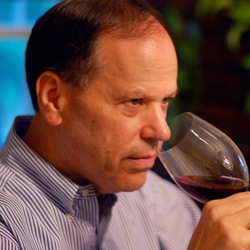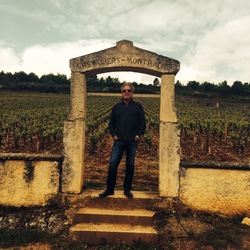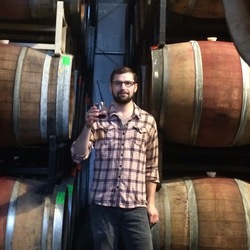Trei Hectare
Château Brane-Cantenac
Grand Cru Classé en 1855 Margaux Red Bordeaux Blend 2005

Domaine De La Grand'Cour (Jean-Louis Dutraive)
Les Clos Cuvée Vielles Vignes Fleurie Gamay 2013
Varietals: Gamay
Organic: Certified
Vineyard: A true clos (walled vineyard) and eight hectare monopole of Dutraive's. Vine age ranges from 30-70 years old. A true clos (walled vineyard) and eight hectare monopole of Dutraive's. Made from the oldest vines in the vineyard, planted in the 1940s.
Orientation: South, southeast-facing
Soil: Pink granite shingles
Viticulture: No herbicides or pesticides, organically farmed, certified since 2009 vintage.
Vinification: Traditional vinification without sulfur and with natural yeast at very low temperatures. Carbonic maceration and little or no filtering.
Aging: 100% in 1-5 year old french oak barrels
Rating: 92 JG
The old vine bottling from Monsieur Dutraive hails from a parcel of sixty-five to seventyfive year-old vines and is raised entirely in Burgundy barrels, ranging from one to five years of age, so there is a little wood influence to this cuvée. The 2013 is outstanding, offering up a deep and nascently complex bouquet of cherries, raspberries, coffee, gamebird, lovely soil tones, spice elements redolent of clove and mace, a bit of mustard seed and a nice touch of cedary new wood. On the palate the wine is deep, full-bodied and youthfully structured, with a sappy core, fine soil signature and a bit of tannin to resolve on the long, youthful finish. This is emphatically not a classic style of Fleurie, but it is an extremely well-made wine whose inspiration seems to be as much Vosne-Romanée as it is Fleurie. The focus and balance here are impeccable and I see no reason this wine will not age superbly well, and for those who are looking for a gateway Fleurie to make the transition from the Côte d’Or to Cru Beaujolais, this is a perfect wine! 2017-2030+. - John Gilman — 11 years ago
Azienda Agricola Andrea Felici
Riserva Castelli di Jesi Classico Verdicchio
2011 vintage one hectare reserva dense and just a baby — 11 years ago
Cullen Wines
Diana Madeline Margaret River Cabernet Sauvignon Blend 2015
Light to medium bodied but has intensity. 2.4 tonnes/Hectare - very low cropping and biodynamic and very Left Bank Bordeaux. Has the Margaret River Herbaceousness. Vanya Cullen prefers this style but I prefer the more masculine Cuvees made by Woodlands and Moss Wood. 87% Cabernet 11% Merlot 1% Petit Verdot and 1% Malbec. Still a classy drop. — 8 years ago
Bass Phillip
Issan Vineyard Pinot Noir 2013
Deep Ruby. Both stalky, sappy and with full berry fruits. A full bodied Pinot from the very close planted Issan Vineyard ( in excess of 9,000 vines per Hectare). A different flavour profile to the equally full bodied Otago Pinots. Phillip Jones calls it a freak wine. We probably drunk it a little too soon as its best years are in front of it- yet delicious now. 15.2% Alc but not noticeable. — 8 years ago
Sadie Family
Mev. Kirsten Chenin Blanc 2012
Beautiful little vineyard - less than 1 hectare - great acidity, skin contact. Old vines.... — 10 years ago
Jules Desjourneys
Fleurie Gamay 2009
2009. Pessac Leognan style...wow, this does not smell like Gamay! Petrol, smoke, cab-like notes of black current, smoke, graphite. This is awesome!! Over 50 year old vines. Very low yields of 18hl/hectare. Whole cluster but no carbonic maceration. Stainless and neutral barrel aging. Fabien Duperray, a name to watch out for! — 10 years ago
Les Terres Blanches (Céline et Benoit Blet)
Les Terres Blanches Pot D' Vache La Vacherie Gamay de Bouze
Vieux livres - Dans les feuilles / Notes poivrées, épicées - cépage gamay de bouze (propriété 1 hectare, assez rapidement épuisé) — 11 years ago
Trei Hectare
Fetească Neagră
Rummy, Trinity, Gill-bodird. Better after breathing. — 11 years ago
Château Giscours
Margaux Red Bordeaux Blend 2014
Located on a beautiful 300 hectare estate, the Giscours vineyard is located in the famous Margaux appellation and eventually included as a Third Growth in the 1855 classification. The young palate on this blend of Cabernet Sauvignon: 70%; Merlot: 20%; and Petit Verdot: 10%; shows ripe berry fruits with pronounced toasty oak notes. The tannins are smooth but needs development. The lingering complex finish shows potential over the next decade. Drink the 2012 if you want something now. — 8 years ago
Pyramid Valley Vineyards
Angel Flower Pinot Noir



Jean Lallement et Fils
Grand Cru Brut Champagne Blend
From 60-year-old vines, the oldest on Lallement's tiny, four hectare estate, the Brut Cuvée Reserve is a blend of 80% Pinot Noir and 20% Chardonnay. This lovely Cuvée shows the winemakers touch, with a fine mousse and creamy texture. Aromas of brioche, red berries, toasted nuts and spring flowers. Subtle and pleasing, with minerality and chalk, balanced acidity and a medium plus finish. — 10 years ago
Giorgio Pelissero
Tulin Barbera d'Alba 2011
This little 1 hectare lot on Barbaresco is on a stiff hillside with brings great minerality .. 5000 bottles made only on the best years. A must try !! — 10 years ago
Peyrassol
La Croix Méditerranée Red Blend 2012
Founded by the Knights of Templar. Continuous production since 1256. 850 hectare estate surrounded by 165 hectares of Mediterranean forest with only 80 hectares planted to vines. — 11 years ago
Domaine du Jaugaret
St. Julien Red Bordeaux Blend 2007
One man, one hectare, one basket press, one wine. THERE CAN BE ONLY ONE...literally. — 11 years ago












Somm David T
Independent Sommelier/Wine Educator
I have a six-pack of this 05. I thought after 10 years in bottle, it would be interesting to check in on its evolution. While tasty, I’ll wait another 8-10 to open another. Even after 2-3 hours in the decanter, it’s still a very young adolescent. On the nose, slightly sour blackberries & dark cherries, dark currants, baked black plum, haunting blue fruits, anise, whiff of spice, steeped tea, dry stones, dry crushed rocks with dry top soil, caramel, vanilla with fresh & dry red florals. The body is thick & full. Tannins are starting to round out. It’s velvety on the palate. The fruits are; bright, fresh & ripe and really show the greatness of the 05 vintage. Dark currants, blackberries, dark cherries, baked black plum, haunting blue fruits, baked strawberries, cherries, raspberries on the long set, dark spice, clay & loamy dry top soil with crushed rocks, dry stones, cigar with ash, graphite, dry stems, slight herbaceous character, mint, used leather, clove, caramel, vanilla, fresh & dry red florals with violets. The round acidity is about perfect. The structure and length are still strong. The balance is in harmony. As for the long finish, it’s lush, ruby, rich and well polished. Photos of; Chateau Brane Cantenac, large wood vats, Henri Lurton and Estate vines. Producer notes and history...Chateau Brane Cantenac began in the early 17th century. At the time, the estate was known as Domaine Guilhem Hosten. Even that far back, wine was produced from the property. In fact, the wine was so highly regarded it was one of the more expensive wines in Bordeaux. It sold for almost as much money as Brane Mouton. This is interesting because of who went on to buy the vineyard in the 1800’s. The Baron of Brane, also known as “Napoleon of the Vineyards”, purchased the Chateau in 1833. At the time of the sale, the estate was called Chateau Gorce-Guy. To get the funds needed to purchase the Margaux vineyard, the Baron sold what is now called Mouton Rothschild, which was at the time of the sale, known as Chateau Brane-Mouton. Not such a good move with hundreds of years in hindsight! In 1838, the Baron renamed property taking his name and the name of the sector where the vineyards were located and called it Chateau Brane Cantenac. The Chateau later passed to the Roy family, who were well-known in the Margaux appellation in those days, as they owned Chateau d’issan. Moving ahead to 1920, the Societe des Grands Crus de France, a group of merchants and growers that owned several chateaux located in the Medoc including; Chateau Margaux, Chateau Giscours, and Chateau Lagrange in St. Julien, purchased Chateau Brane Cantenac. Five years later, M. Recapet and his son-in-law, François Lurton, took over Brane Cantenac along with Chateau Margaux. Lucien Lurton (the son of François Lurton) inherited Brane Cantenac in 1956. Today, the estate is still in the hands of the Lurton family. Brane Cantenac is owned and run by Henri Lurton. After being given the responsibility of managing Brane Cantenac, it was under the direction of Henri Lurton that large portions of the vineyard were replanted. Vine densities were increased, the drainage systems were improved and the plantings were also, slowly changed. The vineyard of Brane Cantenac is planted to 55% Cabernet Sauvignon, 40% Merlot, 4.5% Cabernet Franc and .5% Carmenere. Carmenere was used for the first time in the 2011 vintage. The only other Chateau I know that still uses Carmenere is Clerc Milon. The 75 hectare Left Bank vineyard of Brane Cantenac is essentially unchanged since it earned Second Growth status in the 1855 Classification. At least that is the case with the 45 hectares used to produce the Grand Vin of Brane Cantenac. Those 45 hectares are planted surrounding the Chateau. Those vines are located just in front of the Cantenac plateau and are the best terroir that Brane Cantenac owns. They have other parcels, which are further inland and much of those grapes are placed into their second wine, Le Baron de Brane. Those additional hectares can be divided into 3 main sections. Behind the Chateau, they have 15 hectares of vines on gravel and sand, 10 hectares across the road with sand, gravel and iron and a 13 hectare parcel with gravel called Notton, which is used for their second wine. The vineyard is planted to a vine density that ranges from 6,666 vines per hectare on the plateau and up to 8,000 vines per hectare for the vines located behind chateau, in their sandier soils. The higher levels of vine density are always found in the newer plantings. The terroir of Brane Cantenac consists of deep gravel, sand and clay soil. Experiments in the vineyards are currently looking at becoming more organic in their vineyard management. Today, more than 25% of Brane Cantenac is farmed using organic farming techniques. It is expected that over time, the amount of hectares farmed with organic methods will be increased. Brane Cantenac has gone through 2 relatively recent modernization’s in 1999, when they added began adding the first of their smaller vats to allow for parcel by parcel vinification and then again in 2015 when they completed a much more complete renovation of their cellars and vat rooms. While Brane Cantenac is a traditional producer, they are no stranger to technology as they were one of the first estates to embrace optical grape sorting machines. In very wet vintages, they can also use reverse osmosis. To produce the wine of Chateau Brane Cantenac, the wine is vinified in a combination of temperature controlled, traditional, 22 oak vats, 18 concrete tanks and 20 stainless steel vats that vary in size from 40 hectoliters all the way up to 200 hectoliters, which allows for parcel by parcel vinification. 40% of the fermentation takes place in the oak vats. The oldest vines are vinified in vats that are selected to allow for separate parcel by parcel vinification. The younger vines are vinified more often together in the same vats. However, the Carmenere is entirely micro-vinified, meaning that those grapes were completely vinified in barrel, using micro-vinification techniques. This can also happen because the amount of grapes produced is so small. Some vats can be co-inoculated, meaning they go through alcoholic fermentation and malolactic fermentation simultaneously. At Chateau Brane Cantenac, malolactic fermentation takes place in a combination of French oak tanks and barrels. The wine of Brane Cantenac is aged in an average of 60% new, French oak barrels for 18 months before bottling. The initial 2 months of aging is done with the wine on its lees, which adds more depth to the wine. There second wine is Le Baron de Brane. Le Baron de Brane is not new. In fact, previously, the second wine went under the name of Chateau Notton, which took its name from one of the main parcels where the grapes were planted. During the late 1950’s and into the 1960’s, having a second wine was important as the estate declassified 3 vintages, due to extremely poor, weather conditions in 1956, 1960 and 1963. Production of Chateau Brane Cantenac is about 11,000 cases per year. — 7 years ago